Drama
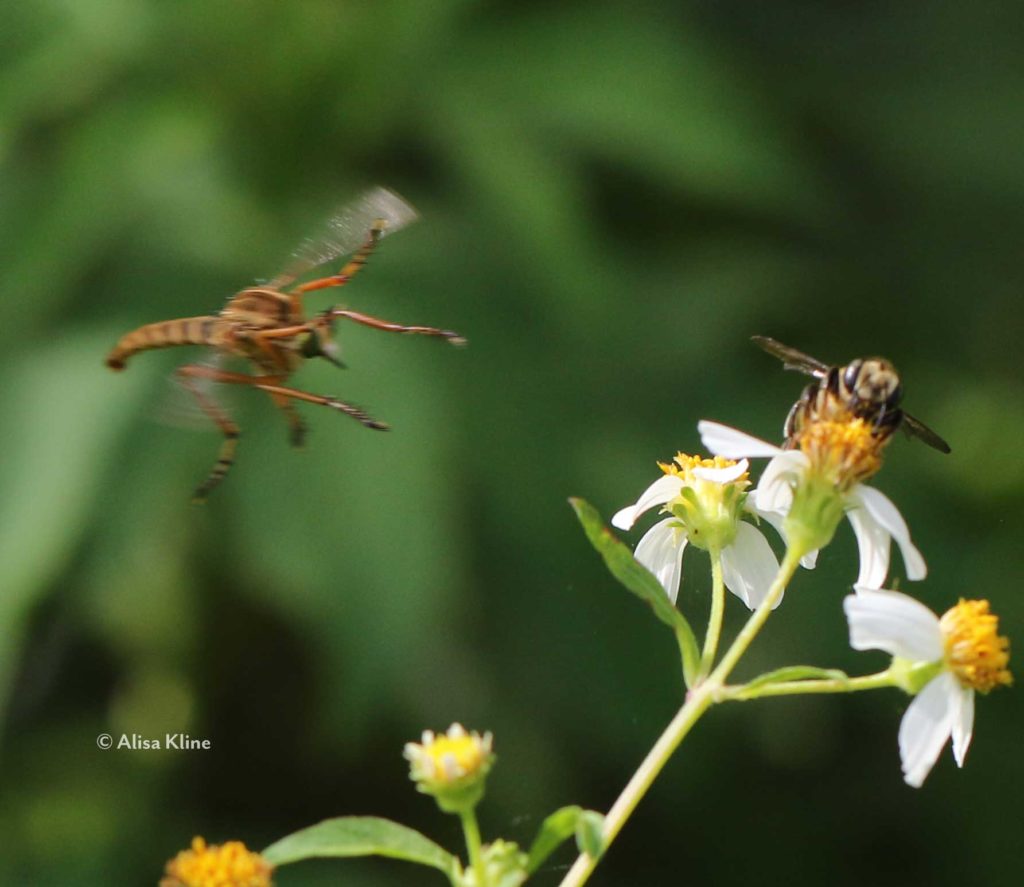
The world consists of eaters and the eaten, who strive mightily not to live out that destiny. From the smallest creature to the largest, the dumbest to our glorious selves, lives are organized around eating (for carnivores that’s killing), avoiding carnivores bigger than ourselves, and sex. Since we’re primates, throw in status and you have the plot of every drama you’ve ever watched.
This is why I’m not upset that this blog focuses on insects so often. Insects are cooperative photographic subjects. They are so busy with eating, not getting eaten, and sex that if you stay still for a while, you will become background and you get to watch the drama unfold on a miniature scale.
And miniature or not, that photo of the bee about to be attacked by a robber fly is awesome. It’s the cheetah catching the impala. But it’s not the kill. It’s that moment just before. It is horror movie stuff. Not gruesome, just the guy with the hatchet waiting behind the tree. It made me gasp when I saw it.
The insect swooping in for the kill is colorfully called a hanging thief. His name is a pun, something you run into from time to time.
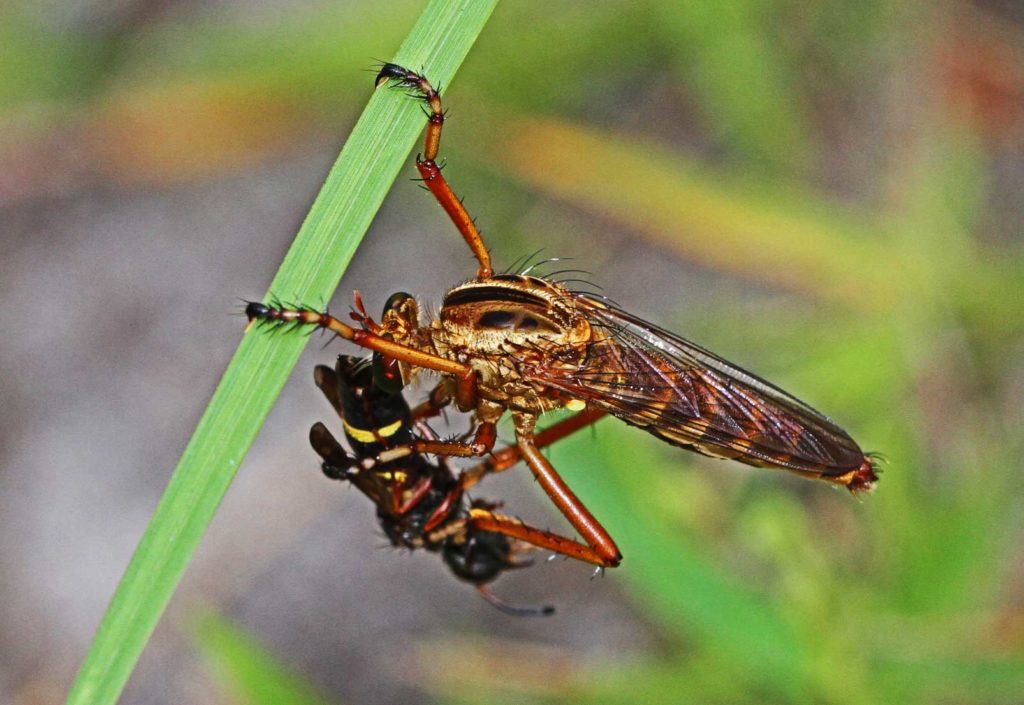
This photo of a hanging thief shows how it got its name. It is hanging by two front legs while eating a tasty insect held by the remaining four. (photo By Judy Gallagher – https://www.flickr.com/photos/52450054@N04/8292885803/, CC BY 2.0, https://commons.wikimedia.org/w/index.php?curid=55251532
To quote from Wikipedia, “Diogmites [hanging thief, latin name] is a genus of mainly neotropical flies in the family Asilidae or robber flies.” Get it? This is a type of robber fly who hangs by one or two of its front feet while it dines on other insects. It’s a hanging thief. From time to time, I run into jokes buried in the names of things. There’s another one hidden in the latin name of the day flower. Follow the link if you’re up for more; the last paragraph relates the joke.
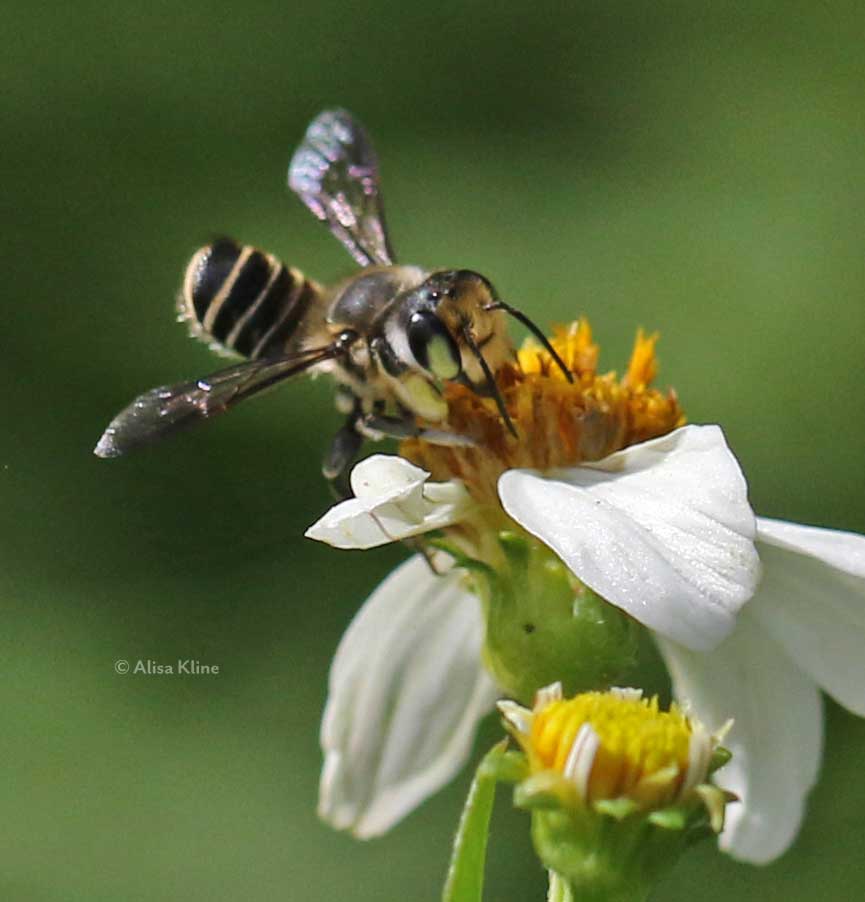
This flat-tailed leaf-cutter bee. Get a load of those green eyes!
The species of bee being menaced in the photo is a flat-tailed leaf-cutter bee. We have a lot of leaf-cutter bees in the Park. There are times of the year when that family seem the most common native bee in the Park. The small private nature preserve I maintain also has a most common bee family, except that one is a carpenter bee.
I don’t know exactly why this is, but guaranteed, it has something to do with eating, not getting eaten, or sex. My educated guess is sex. All bees eat pretty much the same thing, nectar. They occasionally nibble on pollen, but mostly, they use pollen to make loaves of “bee bread” that they will leave next to each egg they lay. That bread is what their offspring will live on through their larval stage.
Different species of bees lay their eggs in different places. They all make protected nests where their unattended babies will be safe and well fed during the larval stage. Only European honey bees make hives. The rest lay their eggs either in holes they chew in wood, holes someone else already chewed in wood, or tunnels in the ground.
I am loaded with carpenter bees because the preserve contains dead stumps a pile of dead branches. That’s just the type of material carpenter bees like to chew their nests into.
Leaf cutter bees are known to nest in any tubular cavity they can find. There are many places in the Park where the ground is very silty. Silt is easy to dig through and I have found a couple of spots were the silty ground is full of small holes. I imagine this is where the bees are nesting.
The remaining mystery is where they are cutting their leaves. They line their cavity with circular pieces of leaf that cut out. They prefer smooth crisp leaves. Roses are popular. These holes will start from an edge and will be almost a perfect circle maybe a half inch or less in diameter. I have searched the Park for cut leaves for a long time and have never found any. If you do, snap a photo and send it to me at blog@AlisaKline.com . Make sure to note where you saw it!
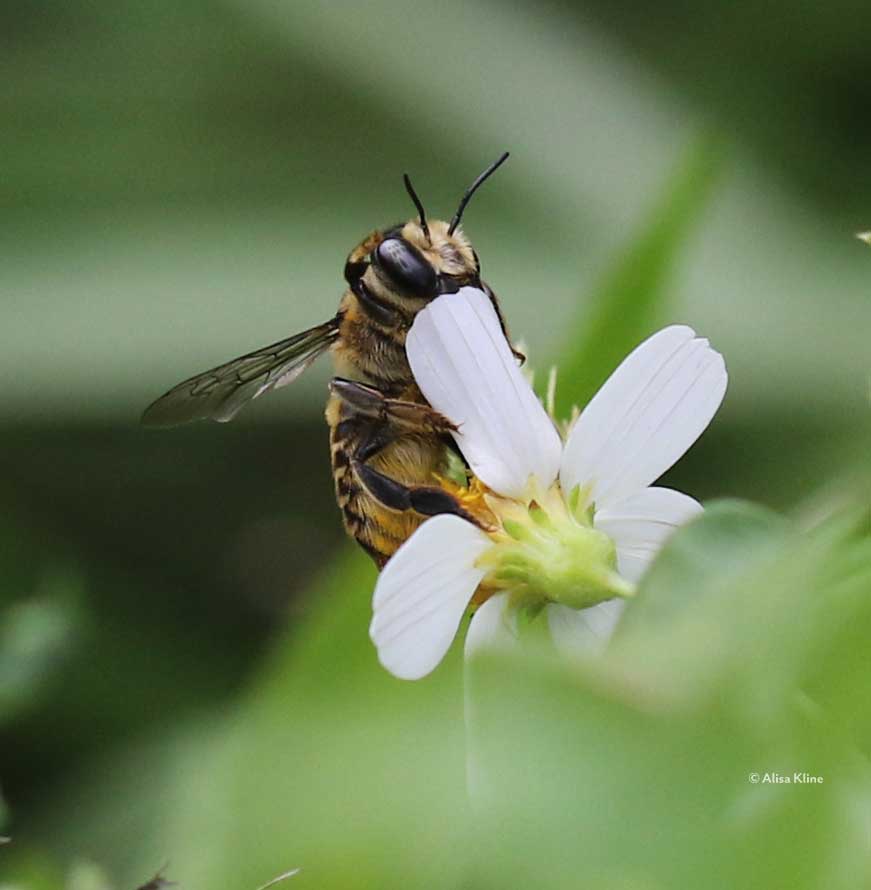
She is just going about her business, but the photograph made her appear to be snuggling the petal so I had to use it. You can also get a good look at her furry belly. All leaf cutter bees carry pollen on furry bellies. It’s the best way to identify them in the wild.
I didn’t know that I had captured the amazing photo of the hanging thief. I was wandering the Park when I caught sight of a bee that looked “wrong,” by which I mean not quite like every other bee I had been seeing. Mostly, we see Eurpoean honey bees. Interesting bees are anything else! As a naturalist, I always want to see something I am unfamiliar with because learning about it will expand my field of view as I try to understand, hopelessly, what’s going on in this place.
My camera view finder is not meant to do much more than let me aim and focus. Detail is not going to be seen. When things are small, far away, or unfamiliar, I often have no idea what I shot until I see the photograph. I have learned to shoot a burst of several photographs in a second. It gives you a chance to catch something cool. Like that hanging thief.
I cannot tell you how often I come home from an adventure with my camera only to find out that I had spent twenty minutes stalking a house sparrow or photographing the umpteenth red-eared slider, certain that this turtle was something different. My last turtle photograph was identified (on iNaturalist) as a common slider. I rejoiced, until I learned that that is now the name for red-eared slider.
The bee that looked wrong was wrong. She was a flat-tailed leaf cutter and apparently they are all the rage right now. I photographed bees in three locations and in each, the “wrong” bee turned out to be a flat-tail.
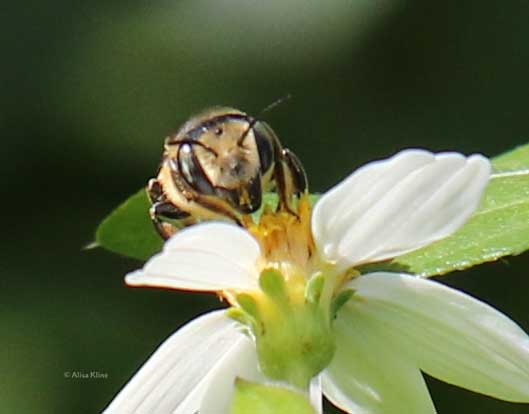
Get a load of her mouth!
As I reviewed my photos, I became fascinated by her mouth which is enormous and oddly shaped. That’s because she’s packing a razor blade in there. Technical term is interdental lamina; she uses it like one of those blades that zip open envelopes; except she uses it to cut circles out of leaves from which she will make her nest.
I took over 200 photos of these bees and I confess that after a while, I got bored looking at them. By the end, I was just flipping through out of a sense of obligation. When I got to the one at the top of the post, I really did gasp.
That is pure menace. I have never seen a robber fly on the hunt. You almost always see them lurking on a plant stem, awaiting a victim. Sometimes you find one dining on the day’s catch. I’ve never seen one attacking. In fact, I can’t find a photo on the internet of a robber fly plying its trade.
Seeing an animal that hasn’t yet noticed death fast approaching triggers us. Our brains are hard-wired to confront danger. Fight or flight, we don’t waste time thinking, the response is immediate and out of our conscious control. The response to avoid death is shared by seemingly the entire animal kingdom. Catching sight of this defining moment gives us chills because we know how that moment feels.

It’s not that clear, but I think you are seeing her proboscis extended between those huge mandibles.
I had another encounter with a fight or flight response this weekend, but this one was more concerning. Since there are lovely photographs to accompany the story, I will tell it to you.
On Sunday, I joined a few friends and went to the San Jacinto Monument to bird and be outside. We got there an hour before the park opened and we took advantage of a low barrier to stroll the entry road while we waited for the park to open.
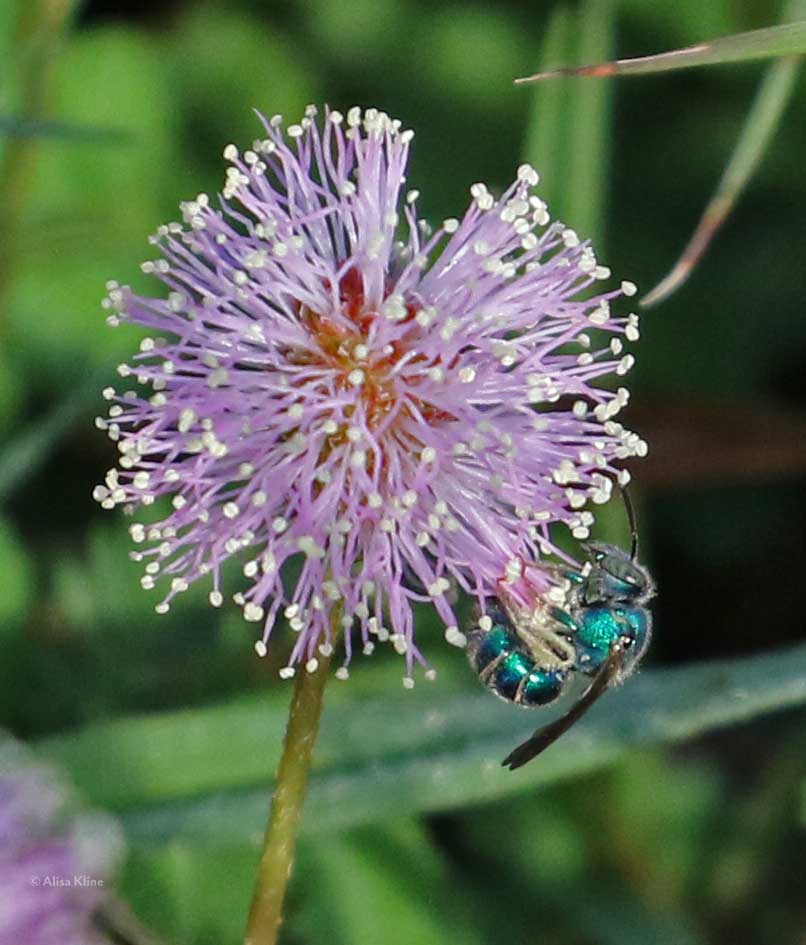
It was lovely. I got this photo of a green metalic sweat bee on the bloom of a sensitive briar. In fact, I was taking this very photo when a gentleman in a car told us that the park was closed and we were to leave.
I was disappointed and it seemed kind of silly, but the level of hostility with which this man approached us was startling. From inside his car, he kept holding up his neck badge and talking sternly about state property and trespassing. The word arrest was used. He followed me in his car, very closely as I walked back down the park entry road, all the while being very vocal about arrests and trespassing. Before I got to the gate, he was replaced by another man in a white pickup truck waiting at the gate. I was grateful to see someone other than Mr. Very-proud-of-my-badge, but this man was, if anything, worse. He filmed everything on his phone, all the while berating us for being just the sort of people who think rules don’t apply to them. It was startlingly personal and with vehemence far out of proportion to the situation.
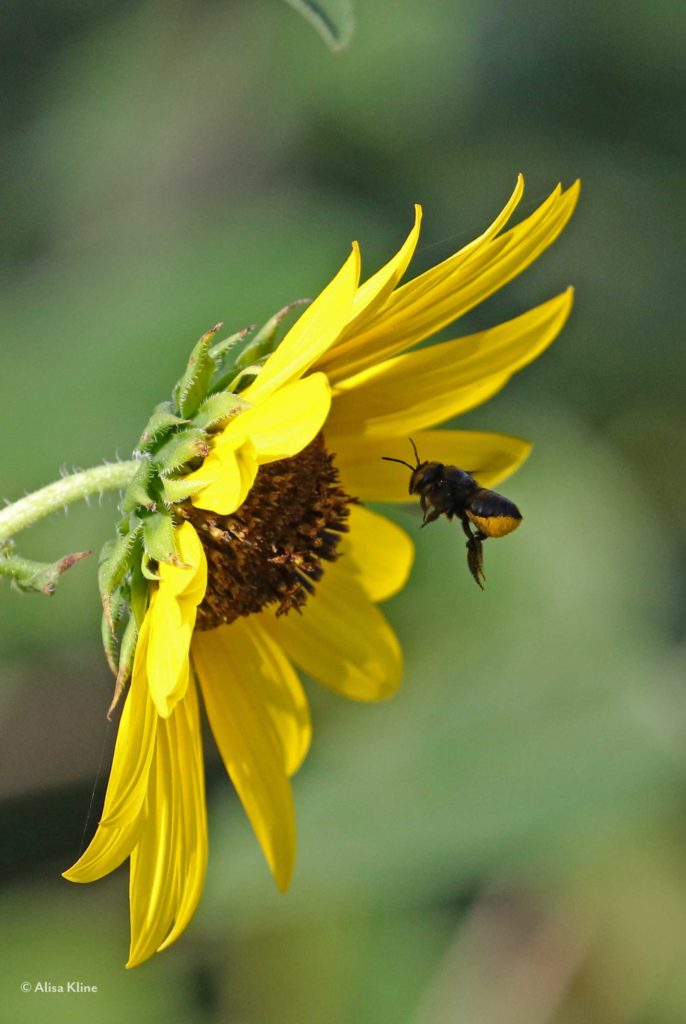
I caught this carpenter-like leaf cutter bee approaching a sunflower just outside the park. Definitely the season for leaf cutters.
Shortly after I walked out of the park, a woman roughly my age (65) came out on a bicycle. She emerged from the park shaking and in tears. She had gotten separated from her group of cyclists and ran into the same treatment we got.
She was frightened enough that her fight or flight response had been triggered. That’s what the trembling and crying were about.
Perhaps the San Jacinto Monument is secretly a nuclear launch site; I cannot think of another reason to threaten apparently several groups of older women who in defiance of a sign saying the park opened at 9 and a barrier that is more announcement than blockade dared to enter the park an hour early. And honestly, 9 is too late to open any outdoor venue in August.
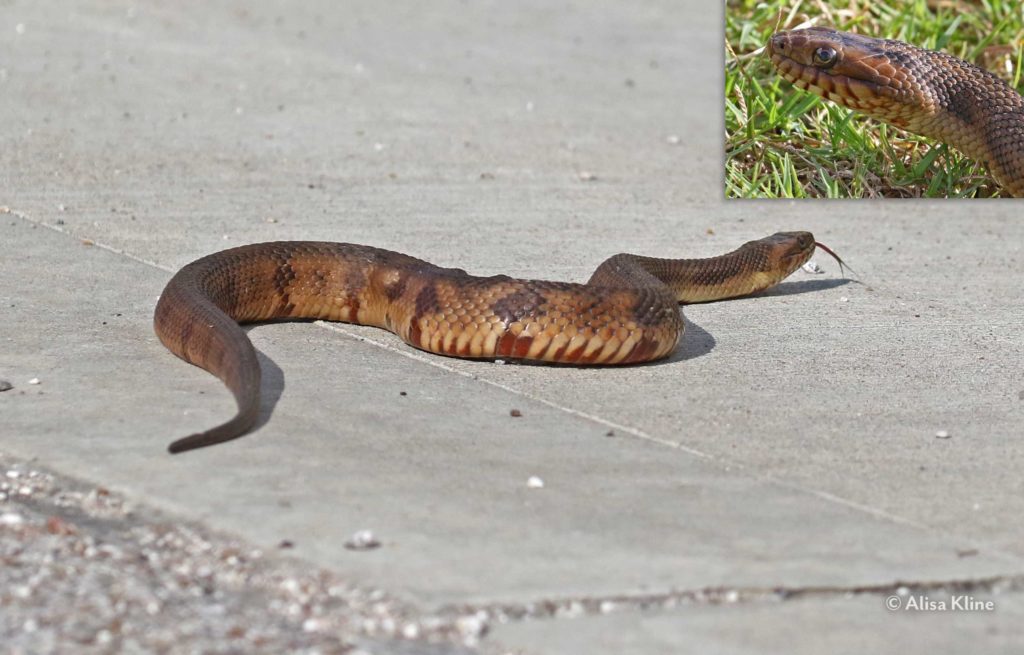
I saw a very cool snake while I waited for the park to actually open. A broad banded water snake crossed the road. Luckily I had a really long lens in my hand because that was a pretty large snake and I didn’t have time to figure out an ID. I wanted the photo!

